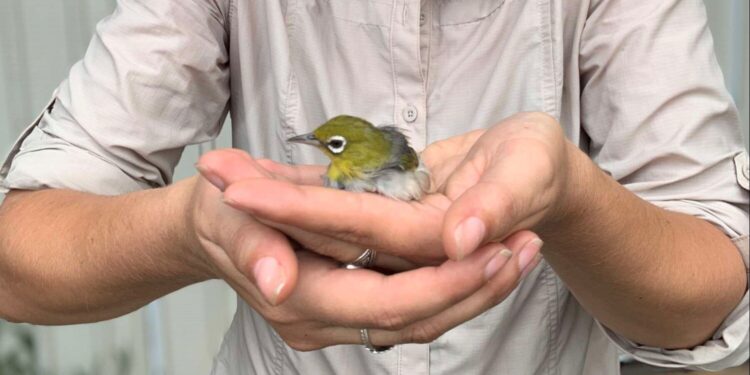A bird in the hand: Annika Radu holds a shark during her research on Lady Elliot Island. Credit: Christine Dudgeon
A small yellow and white bird that prefers to hang out with its mates in an idyllic island lifestyle rather than flying to the mainland to mingle with others is an example of avian evolution in action, according to new Australian research.
The University of the Sunshine Coast paper, published in Scientific reports on naturehas studied the genetic divergence of the Silver-eyed Capricorn population on Lady Elliot Island since the species was first observed there in the 1980s.
The study found that the species, known for its rapid reproduction and monogamy, had already developed genetic distinction in less than five decades on the southern Great Barrier Reef island.
UniSC animal ecologist Dr Dominique Potvin said genetic markers indicated the bird had chosen to stay and play on the resort side of the island for its entire life rather than seek out other silvereye populations.
“This is a rapid rate of genetic divergence, with the silvereye Zosterops lateralis now one of the most common landbird species on the island,” she said. “It can easily fly long distances, but chooses not to visit the Queensland mainland or other islands.”
Dr Potvin, who supervised the collaborative study led by UniSC Honours graduate Annika Radu, said there were three subspecies of silvereyes in Queensland and its reef islands.
-
Just a little moment in the corner: the silvereye. Photo: Annika Radu
-
Credit: University of the Sunshine Coast
“A lot of individuals migrate from Tasmania to Queensland and back every year, so it’s not like they can’t move,” she said. “This study confirms previous research showing that Great Barrier Reef birds are slowly evolving away from mainland species.”
“Silvereyes are known for this, but most studies have looked at them at the species level, as in the entire South Pacific, rather than at the local level.
“We are witnessing species divergence/evolution in action,” Dr. Potvin said.
Radu said the study compared bird samples from Maryborough, the Sunshine Coast, Lady Elliot Island and Heron Island northeast of Gladstone.
September is the breeding season for this bird with a distinctive white ring around the eye, which nests in trees and feeds on invertebrates and fruit. There are 17 subspecies of Silvereye in Australia and the South Pacific.
The paper, ‘Genetic patterns reveal geographic drivers of divergence in silvereyes’, was co-supervised by UniSC Associate Professor Kathy Townsend and co-authored by UniSC Principal Investigator Christine Dudgeon, UniSC’s Dr Alexis Levengood, Sonya Clegg and Ashley Sendell-Price from the University of Oxford and Yasmin Foster from the University of Otago.
More information:
Annika Radu et al., Genetic patterns reveal geographic drivers of divergence in Zosterops lateralis, Scientific reports (2024). DOI: 10.1038/s41598-024-71364-9
Provided by the University of the Sunshine Coast
Quote: Love Island: Bird’s refusal to leave resort life leads to genetic change (2024, September 19) retrieved September 19, 2024 from
This document is subject to copyright. Apart from any fair dealing for the purpose of private study or research, no part may be reproduced without written permission. The content is provided for informational purposes only.



